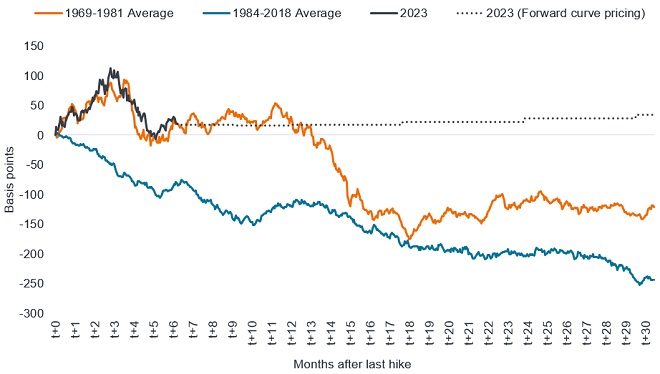Subscribe
Sign up for timely perspectives delivered to your inbox.
Jenna Barnard and John Pattullo, Co-Heads of Global Bonds, explain why the inflation battle is fast becoming yesterday’s news. As attention turns to rate cuts, they look back through history to gauge the potential direction for bond yields.

It is more than back on track, it has exceeded expectations. This is contrary to economic models that saw a need for significantly higher unemployment to drive core inflation down. Bear in mind that back in June 2023, the US Federal Reserve (Fed) forecast that core inflation (core PCE) by Q4 2023 would be 3.9%1 (percentage change on the same quarter a year ago). The actual figure turned out to be 3.2%.2 Similarly, in Europe we have seen core inflation materially surprise on a downward trend and outright deflation (declining prices) in China. It turns out central banks might ultimately have been right in saying inflation was transitory. The European Central Bank (ECB) published a recent working paper (Jan 2024) that estimated only 10% of core inflation since summer 2021 was due to demand shocks, with most of the remainder due to supply shocks.3
The bond market did celebrate during November and December of 2023 as the Fed signalled a more dovish tone. But it is true that the fall in US 10-year Treasury yields only brought us back to where yields were in summer 2023, when the Fed did its last hike.
Assuming the Fed’s July 2023 hike was the last of this cycle we researched the historical performance of US 10-year Treasury bonds in rate cutting cycles from 1969. This approach differs from the typical bond market approaches used to estimate where 10-year yields may end up which are based on unobservable concepts such as term premium or r* (the real neutral rate of interest). It also gives a very different conclusion: 10-year bond yields have historically always fallen materially below the level that they were at the date of the last rate hike (3.87% in July 2023). In contrast, market forward pricing currently prices in the opposite conclusion: that 10-year yields will not fall below 3.9% in the coming years.
This is illustrated in the chart below showing the change in the US 10-year Treasury yield after the last hike, with T+0 representing the date of the last hike. To summarise the conclusions, we separated this out to two historical periods: the 1969-81 period (characterised by rising and high inflation) and the 1984-2018 period (characterised by declining or low inflation). Overlaid is the most recent experience (from July 2023) and the forward pricing in bond markets, i.e the path priced in for yields using the forward curves. Recall that a rise in yields leads to a fall in bond prices and vice versa, so a declining line would indicate falling yields and rising bond prices.
Change in US 10-year Treasury yield after last rate hike

Source: Bloomberg, Janus Henderson calculations, 30 January 2024. Basis point (bp) equals 1/100 of a percentage point, 1bp = 0.01%. Past performance does not predict future returns. There is no guarantee that past trends will continue, or forecasts will be realised.
That’s right. If you look out over the next 18 months, regardless of which path yields take, on average they end up considerably lower. More conclusively, 10-year bond yields always fall in a rate cutting cycle. They may trade sideways for some months (orange line) while that debate is ongoing, but even in the worst-case scenario we could find (which was back in 1974-75) 10-year yields bottomed 70 basis points below where they were at the last hike. If that were repeated this time, it would still take 10-year yields down to 3.2%, which is 70 bps below the 3.9% level they were at on 26 July 2023 when the Fed did its last hike.
Conversely, we could reconnect with the blue 1984-2018 path, which could see yields down 150-200 basis points over the next 18 months.
Central banks are effectively telling us. The Fed made it clear in its December 2023 Summary of Economic projections that it forecast interest rate cuts in 2024 and even more in 2025. If you take the final six months of 2023, core PCE in the US was actually at 1.9% annualised, so even lower than the year-on-year rate. With inflation back towards 2% and the Fed rate currently at 5.25%, that is a real interest rate (difference between policy rate and inflation rate) of more than 3%. The Fed will not want real rates to be so restrictive so we think rates could easily fall 200 basis points in the coming 18 months. As we noted earlier, inflation has come down already so central banks don’t need to force through unemployment to rein in prices.
In Europe, the Eurozone economy has barely grown, so we could see the ECB move first on rate cuts – potentially as soon as April. In the recent rate hiking cycle there was a high degree of synchronicity in rate hikes by developed market central banks and we think once one of the major central banks moves lower, others will follow suit, albeit at different speeds. We could see a lot of money move out of money market funds and cash deposits into bonds to try and lock in current yields.
1Source: Federal Reserve, Economic projections, June 2023.
2Source: BEA, Personal Consumption Expenditures Index, excluding Food and Energy (Core PCE), percentage change on same quarter a year ago, December 2023.
3Source: ECB, Roberto A. De Santis, Working paper Series, No 2884, January 2024. The views expressed are those of the author and do not necessarily reflect those of the ECB.
There is no guarantee that past trends will continue or forecasts will be realised.